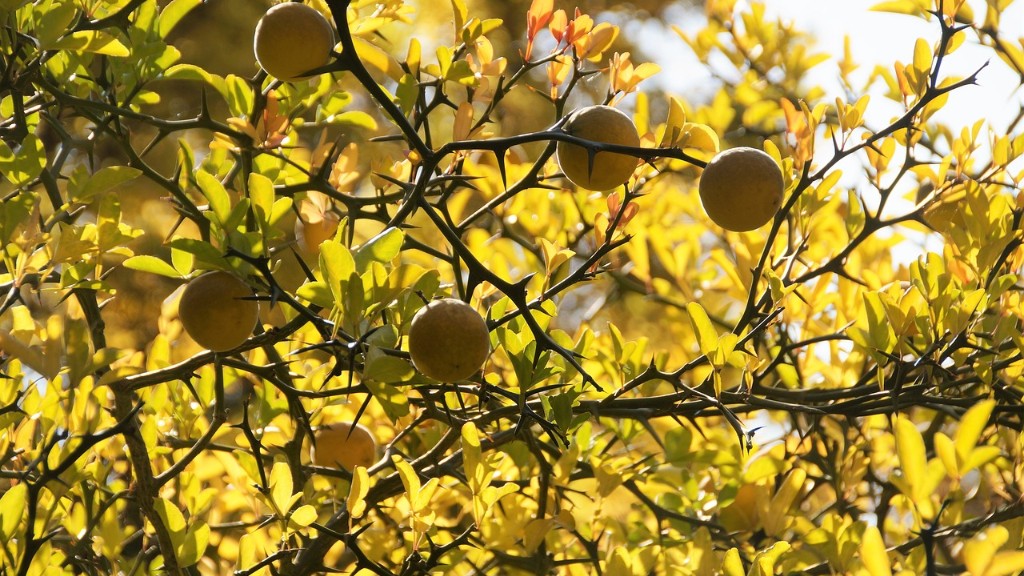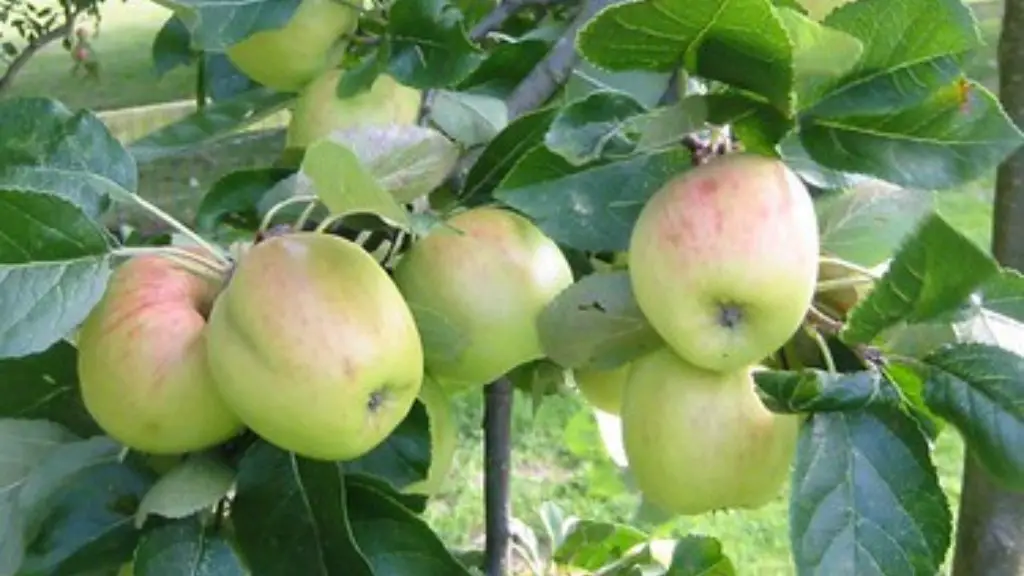The lemon tree is one of the most widely cultivated fruit trees in the world. Its distinctive and tart-tasting fruits have proven to be a source of culinary delight, as well as a powerful addition to many medicines and health remedies. But when exactly will a lemon tree start producing its yellow-hued and lemony tasting wonders?
As with most fruit-bearing trees, the answer to when a lemon tree will produce fruit depends on a variety of factors. Climate, being anyone of the primary influencers, has a large part to play on when the fruit will appear. Lemon trees require a warm and temperate climate in order to thrive and produce fruit, usually in the range of 15 to 25° Celsius. If planted in areas where temperatures drop below this range, the lemon tree will likely not produce any fruit at all.
Additionally, the age and size of the lemon tree will also determine when the fruit will be ready to harvest. In general, a lemon tree usually won’t begin to bear fruit until it is at least three or four years old. That being said, the tree can generally reach full maturity within six to eight years, meaning that it is likely to start producing fruit earlier for those who actively maintain and care for their trees.
Fertilization can also play a role in when a lemon tree will produce fruit. When fertilizing the tree, the use of an organic fertilizer is always advisable, as it will help to improve the health and well-being of the tree while also encouraging fruit production. In particular, nitrogen-rich fertilizers are known to stimulate the lemon tree’s flower production, helping it to produce an abundance of fruit when the fruit-bearing season arrives.
Finally, it is also worth noting that lemon trees tend to be seasonal in nature – that is, they will only produce fruit during predetermined times throughout the year. In warm climates, for example, a lemon tree may produce its first fruits in the spring and continue to produce until fall or even winter. These seasonal cycles should be taken into consideration when wondering when to expect fruit from a lemon tree.
Types of Lemon Trees
Different types of lemon trees can produce fruits ranging in size and sweetness, with some varieties being able to bear fruit all year round in warmer climates. The four most commonly grown types are Meyer, Eureka, Villafranca, and Lisbon lemons. The Meyer lemon, in particular, is a hybrid variety that is particularly known for its sweet and mellow flavor. As for the Eureka and Lisbon trees, these varieties tend to produce fruits that are usually larger and more acidic in taste.
As for the Villafranca tree, it is a cross between a Lisbon and a Meyer lemon, meaning it produces fruits that are of a moderate size, with a balance between sweet and sour flavors. The ripening season for Villafranca lemons can start as early as winter and last until spring, making them the ideal option for anyone who is seeking fruit year round.
Finally, there are also dwarf varieties of lemon trees available, which are perfect for those who may have limited space available. While these trees are unlikely to ever reach full maturity, they still have the potential to offer fruits that are of excellent quality. What’s more, managing and maintaining a dwarf tree tends to be less demanding than traditional full-size lemons trees.
Common Diseases
Like any other fruit-bearing species, lemon trees can become vulnerable to a number of diseases and common pests. While preventive measures, such as regularly pruning the trees and using organic pesticides, can help to protect them from such things, it is still important to identify and address any issues that may arise promptly.
Aphid infestations, for example, are a fairly common occurrence for a lemon tree. These tiny, pear-shaped insects particularly target the young leaves, stems, and flowers of the tree, sucking nourishment from them. To both prevent and treat an aphid infection, it is best to use an environmentally-friendly insecticide, ensuring that all surfaces are treated thoroughly.
On the other hand, fungal diseases, such as powdery mildew, can also threaten the health and wellbeing of lemon trees. To treat this, a fungicide should be used, preferably one that is non-toxic and not-harmful to the environment. Additionally, it is important to make sure the foliage of the lemon tree is kept dry and free of any excess moisture.
Root rot can also prove to be a major problem for lemon trees.While this is a serious condition and difficult to fully fix, an anti-fungal spray can help to both treat the issue and prevent it from developing further. As with other diseases, it is essential that the root rot be managed correctly and promptly, as it can cause significant damage to the tree if left untreated.
Pruning and Harvest
The key to ensuring a lemon tree produces the best yield of fruit possible is by proper pruning and maintenance. Pruning should be conducted regularly, noting that any old or damaged branches should be removed in order to encourage the growth of new, healthy branches. Pruning also helps to promote the flow of nutrients and energy to the more important sections of the tree.
Additionally, it is important to properly harvest the fruits off the tree as they start to appear. The best time to pick them is when they are just beginning to turn yellow, as this is when they are at their sweetest and juiciest. It’s also worth noting that fruits should be harvested with care, as pulling them off with too much force can damage the tree and discourage further production.
Finally, it is often beneficial to apply a mild fertilizer shortly after the harvesting of fruit has been completed. This can help to replenish the essential nutrients that may have been lost from the tree during the harvesting process.
Tools and Safety
When undertaking the task of pruning, harvesting, and caring for a lemon tree, it is essential to ensure that all required safety precautions are taken. This is particularly important for the removal and disposal of any dead or damaged branches, as any remaining bits and particles can provide havens for pests such as aphids.
Additionally, the use of the correct tools for pruning and harvesting is essential. Hand shears and loppers, for example, are great tools for pruning and cutting off branches, while curved harvesting shears are ideal when it comes to safely harvesting the delicate fruits.
Finally, it is also important to remain aware of your own safety when dealing with lemon trees. This is a particularly relevant consideration for taller trees, as climbing and reaching for fruits or branches can be quite dangerous. If this is the case, it is best to employ the help of someone who is experienced in such matters or use a custom-built system for harvesting the fruits.
Environmental Factors
The environment holds a primary role when it comes to the health and wellbeing of lemon trees, as well as determining when they start to produce fruit. As already mentioned, lemon trees require a warm and temperate climate in order to thrive. Sources of light, such as direct sunlight, are also essential for the growth of a lemon tree, as is the presence of water, humidity, and fertile soil.
In regards to water in particular, it is important to note that while lemon trees typically require regular watering, they can be vulnerable to root rot if there is an excess of water. As such, it is essential to ensure that there is a balance between moisture and dryness in the soil, particularly during the hot and dry summer months.
In addition to this, temperatures can also have a major influence on whether or not a lemon tree will produce fruit. Factors such as a sudden drop or spike in temperatures can stunt the tree’s flowering or fruit production, meaning it is important to be as mindful as possible for any sudden climate changes.
Finally, be wary of any pesticides or fertilizers you are using on the tree. It is best to always use natural and non-toxic products to help provide nourishment and protection to the tree in order to ensure its long-term wellbeing and fruit production.
In Summary
When it comes to when a lemon tree will start producing fruit, the answer lies in a variety of factors, primarily being the age, size, and climate of the tree. Additionally, it is important to use the right tools and safety practices when tending to the tree, as well as understand the environmental factors and conditions that can impact its growth and productivity.




